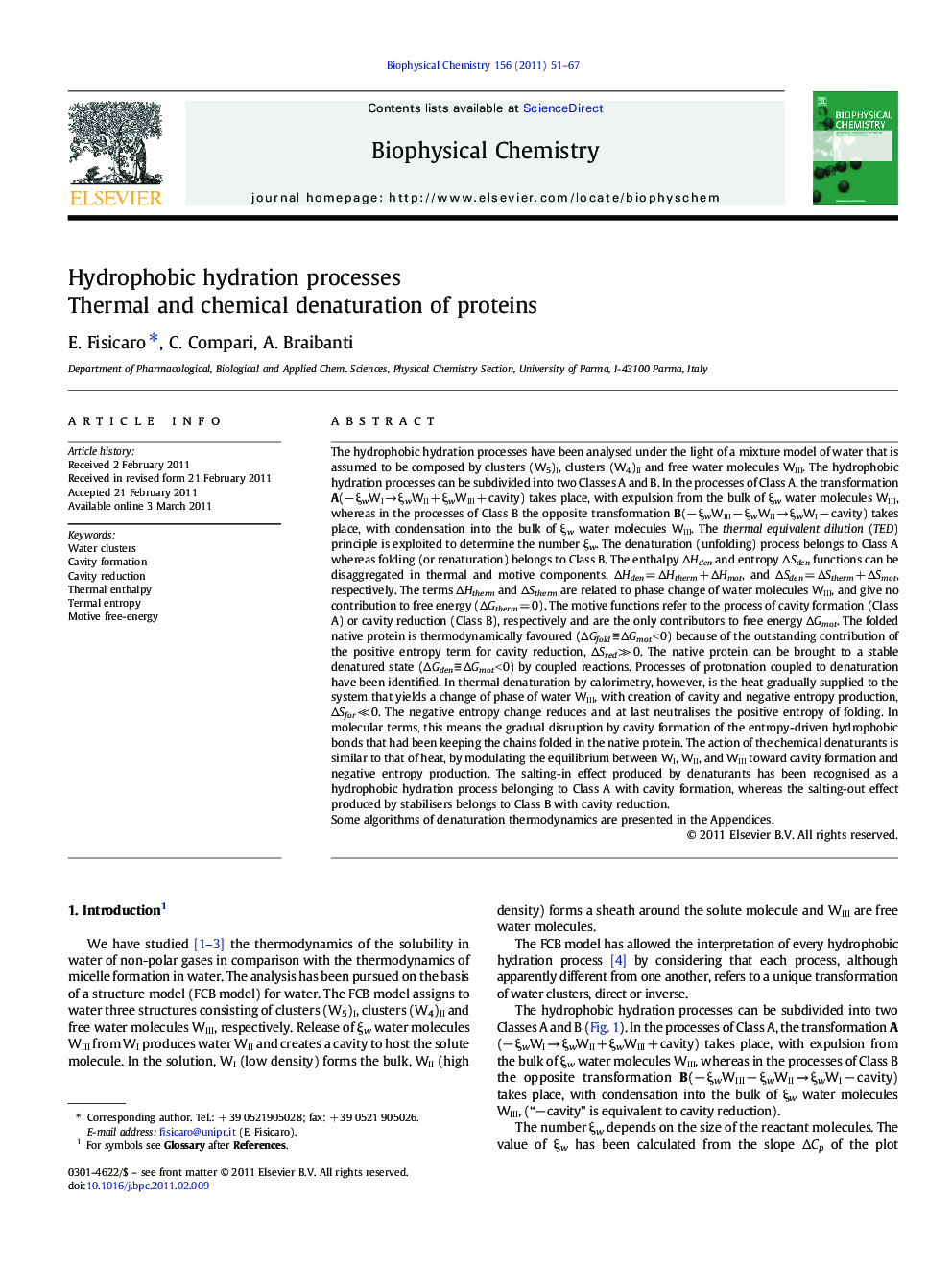| کد مقاله | کد نشریه | سال انتشار | مقاله انگلیسی | نسخه تمام متن |
|---|---|---|---|---|
| 5371502 | 1388824 | 2011 | 17 صفحه PDF | دانلود رایگان |

The hydrophobic hydration processes have been analysed under the light of a mixture model of water that is assumed to be composed by clusters (W5)I, clusters (W4)II and free water molecules WIII. The hydrophobic hydration processes can be subdivided into two Classes A and B. In the processes of Class A, the transformation A(â ξwWI â ξwWII + ξwWIII + cavity) takes place, with expulsion from the bulk of ξw water molecules WIII, whereas in the processes of Class B the opposite transformation B(â ξwWIII â ξwWII â ξwWI â cavity) takes place, with condensation into the bulk of ξw water molecules WIII. The thermal equivalent dilution (TED) principle is exploited to determine the number ξw. The denaturation (unfolding) process belongs to Class A whereas folding (or renaturation) belongs to Class B. The enthalpy ÎHden and entropy ÎSden functions can be disaggregated in thermal and motive components, ÎHden = ÎHtherm + ÎHmot, and ÎSden = ÎStherm + ÎSmot, respectively. The terms ÎHtherm and ÎStherm are related to phase change of water molecules WIII, and give no contribution to free energy (ÎGtherm = 0). The motive functions refer to the process of cavity formation (Class A) or cavity reduction (Class B), respectively and are the only contributors to free energy ÎGmot. The folded native protein is thermodynamically favoured (ÎGfold â¡Â ÎGmot < 0) because of the outstanding contribution of the positive entropy term for cavity reduction, ÎSred â«Â 0. The native protein can be brought to a stable denatured state (ÎGden â¡Â ÎGmot < 0) by coupled reactions. Processes of protonation coupled to denaturation have been identified. In thermal denaturation by calorimetry, however, is the heat gradually supplied to the system that yields a change of phase of water WIII, with creation of cavity and negative entropy production, ÎSfor âªÂ 0. The negative entropy change reduces and at last neutralises the positive entropy of folding. In molecular terms, this means the gradual disruption by cavity formation of the entropy-driven hydrophobic bonds that had been keeping the chains folded in the native protein. The action of the chemical denaturants is similar to that of heat, by modulating the equilibrium between WI, WII, and WIII toward cavity formation and negative entropy production. The salting-in effect produced by denaturants has been recognised as a hydrophobic hydration process belonging to Class A with cavity formation, whereas the salting-out effect produced by stabilisers belongs to Class B with cavity reduction.Some algorithms of denaturation thermodynamics are presented in the Appendices.
Research Highlights⺠The Hydrophobic Hydration Processes in water belong to Class A or B. ⺠Class A implies forming a cavity in the solvent water and Class B reducing the cavity. ⺠Cavity formation (A) is entropy consuming and reduction (B) is entropy producing. ⺠Protein denaturation belongs to Class A and renaturation to Class B. ⺠Chemical denaturants template for cavity formation (A) and stabilisers for reduction (B).
Journal: Biophysical Chemistry - Volume 156, Issue 1, June 2011, Pages 51-67